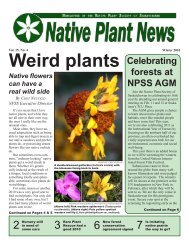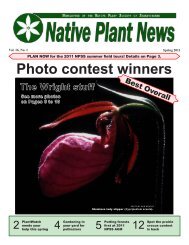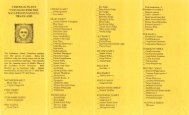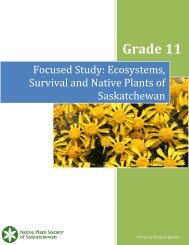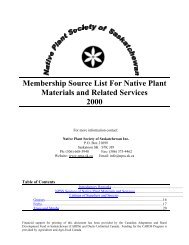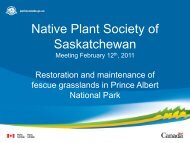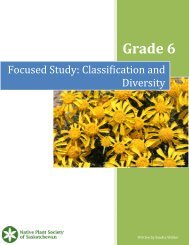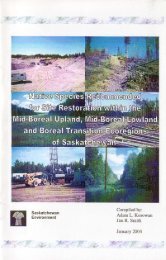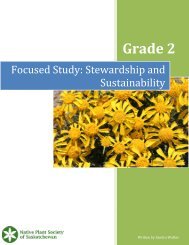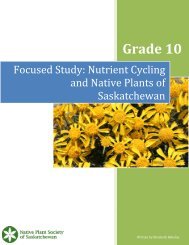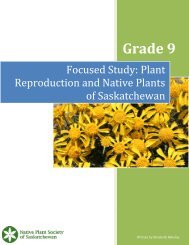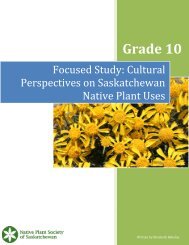Endemic vascular plant taxa of the Athabasca Sand Dunes of ...
Endemic vascular plant taxa of the Athabasca Sand Dunes of ...
Endemic vascular plant taxa of the Athabasca Sand Dunes of ...
Create successful ePaper yourself
Turn your PDF publications into a flip-book with our unique Google optimized e-Paper software.
The endemicsCharacteristicSilveryDensely hairy, woollyCurved leaf edgesToughened cuticleFast apical growthFlexible stemsAdventitious rootingRhizomatous growthModeratesReflects incoming UV, lessens heat in chlorophyllReduces heat buildup and moisture loss, traps dewReduces moisture lossResists damage from sand abrasionResists sand burialReduces wind and sand damageSurvives burial, support structureSurvives burial, reproduction without seed
<strong>Athabasca</strong> Thrift - Armeria maritima ssp. interiorD. Guedo
Mackenzie Hairgrass - Deschampsia mackenzieanaC. Neufeld
Turnor’s Willow- Salix turnoriiS. VingeC. Neufeld
Tyrell’s Willow- Salix tyrelliiG. Longpre
Floccose Tansy – Tanacetum huronense var. floccosumS. Vinge
Risks• Potential risks to endemic species:◦ Climate change and species shift◦ Ecotourism◦ ATVs◦ Mineral exploration◦ Exotic species invasion◦ Acid depositionG. Longpre• To evaluate risks, we need understand <strong>the</strong>habitats and abundances <strong>of</strong> <strong>the</strong> endemic species
Objectives• Quantitatively document <strong>the</strong> distribution andabundance <strong>of</strong> <strong>the</strong> endemics occurring in <strong>the</strong><strong>Athabasca</strong> <strong>Sand</strong> <strong>Dunes</strong>
Study design and methods◦ Transects• stratified random fashion – foreststand, dune type, distance
Data collection - Habitat• Slope◦ Upper, mid, lower• Aspect• Erosional status◦ Erosional, depositional, static• HabitatG. Longpre
Wet inter-dune slack (WIDS)S. Vinge
Saline inter-dune slack (SIDS)S. Vinge
Gravel pavement (GRPV)S. VingeC. Neufeld
Low slope gradient dune (LSDN)A. Tucker
High slope gradient dune (HSDN)S. Vinge
Lichen-crowberry-hea<strong>the</strong>r (LICH)G. Longpre
Woodland (WOOD)S. Vinge
Data collection - Vegetation• Individuals◦ Forbs - separated by 20cm◦ Willows - individual stems• Patches◦ Separated by 2m◦ Size measured by ellipse:longest x perpendicular axis• Search area◦ Forbs - 4m x 250m◦ Willows - 10m x 250mG. Longpre
Collection summary• Sampled in major dune fields:• William River, Thompson Bay, Cantara Lake, Archibald Lake andYakow Lake• 206,138 endemic individuals observed• 230 transects
Habitat summary92517115910684587Figure 1: Kilometers <strong>of</strong> transect surveyed in each habitat type. Superscript numbers indicatenumber <strong>of</strong> habitat segments sampled in each habitat type.
<strong>Endemic</strong> observation summaryTable 1: Count <strong>of</strong> total observations and <strong>the</strong> relative abundance (percentage <strong>of</strong> total number <strong>of</strong>observations) <strong>of</strong> each <strong>taxa</strong> in <strong>the</strong> occupancy survey. Note that <strong>the</strong> relative abundance numbersare not adjusted for <strong>the</strong> wider search area for <strong>the</strong> willows.SpeciesAchillea millefoliumArmeria maritimaDeschampsia mackenzieanaSalix brachycarpaSalix silicicolaSalix turnoriiSalix tyrelliiStellaria arenicolaTanacetum huronenseCount592 (0.29)272 (0.13)14213 (6.89)28224 (13.69)23740 (11.52)15634 (7.58)114025 (55.31)3810 (1.85)5628 (2.73)
Achillea millefoliumD. Guedo◦ Low abundance◦ Highest occurrence in WIDS, <strong>the</strong>n WOOD• Limited ability to tolerate burial by sand• Susceptible to acid deposition and traffic given habitat affinities
Armeria maritimaD. Guedo◦ Species with least occurrences◦ Grows on more stable habitats such as gravel pavements◦ Poorly adapted to sand burial and excavation• Taproot damage from traffic on GRPV and slacks• Susceptible to acid deposition given habitat affinities
Deschampsia mackenzieanaC. Neufeld◦ Most frequently encountered species◦ Occupancy highest on low-sloping dunes◦ Often occurred in <strong>the</strong> absence <strong>of</strong> o<strong>the</strong>r species• Acid deposition may impact germination requirements
Stellaria arenicolaS. Vinge◦ Most occurrences in WIDS, SIDS and HSDN◦ Susceptible to acid deposition and traffic given habitat affinities
Tanacetum huronenseD. Guedo◦ Most occurrences on WIDS, HSDN and SIDS◦ Seems to tolerate burial - vigorous rhizomatous growth• Susceptible to acid deposition and traffic given habitat affinities
Salix brachycarpaD. Guedo◦ Most occurrences on WIDS and SIDS
Salix silicicolaD. Guedo◦ Occurs similarly on all habitats, lower occurrences WOOD andGRPV
Salix turnoriiS. Vinge◦ Occurs similarly on all habitats, lower occurrences on WOOD andLICH
Salix tyrelliiG. Longpre◦ Occurs most frequently on WIDS, WOOD and LICH
<strong>Endemic</strong> species richnessFigure 2: <strong>Endemic</strong> richness (number <strong>of</strong> species with at least one individual present in a habitatsegment) in each major habitat type. The letters above <strong>the</strong> whiskers indicate groups <strong>of</strong> habitatsthat differ significantly in <strong>the</strong>ir mean species richness. The thick horizontal line is <strong>the</strong> median,and <strong>the</strong> lower and upper bounds <strong>of</strong> <strong>the</strong> box represent <strong>the</strong> 25 th and 75 th percentiles respectively.
• Saskatchewan Parks Service (2009 financial contribution)• Habitat Stewardship Program (2010 financial contribution)• Parks Service, Ministry <strong>of</strong> Tourism, Parks, Culture and Sport◦ Dr. Rob Wright, Bob Wilson, Glen Longpre, J. R. Smith, Kelvin Kelly• Environmental Protection Branch, MOE◦ Murray Hilderman, Allison Tucker• Environmental Assessment Branch, MOE◦ Sarah James• Information Management and Geomatics Services Branch, MOE◦ Mike Andersen• Fish and Wildlife Branch, MOE◦ Jeanette Pepper, Jeff Keith, Sue McAdam• Native Plant Society <strong>of</strong> Saskatchewan◦ Chet Neufeld• Department <strong>of</strong> Plant Sciences, U <strong>of</strong> S◦ Dr. Eric Lamb, Digit Guedo, Jenalee Mischkolz, Amanda Guy• Nature Saskatchewan◦ Jessus Karst, Matt Weiss, Sarah Vinge• National Museum <strong>of</strong> Canada◦ Dr. George Argus• Canadian Wildlife Services, EC◦ Candace Neufeld, Darcy Henderson, Sarah Lowe• Independent Consultants◦ Anna LeightonK. Kelly
ReferencesEnvironment Canada (2011) Species at risk registry.http://www.sararegistry.gc.caJonker, P.M. & Rowe, J.S. (2001) The sand dunes <strong>of</strong> Lake <strong>Athabasca</strong>: ouradventure in learning. University Extension Press, Saskatoon, SK.Lamb, E.G. (2010) The distribution and abundance <strong>of</strong> <strong>the</strong> endemic <strong>vascular</strong><strong>plant</strong> <strong>taxa</strong> <strong>of</strong> <strong>the</strong> <strong>Athabasca</strong> <strong>Sand</strong> <strong>Dunes</strong> <strong>of</strong> nor<strong>the</strong>rn Saskatchewan.Unpublished report to <strong>the</strong> Canadian Wildlife Service (Environment Canada)Thanks!Report accessible online:http://homepage.usask.ca/~egl388/index.html
Table 5: Summary <strong>of</strong> survey extent including transect length (km) and number <strong>of</strong> habitat units ineach major habitat type.HabitatKmSurveyed# habitatunitsAverage unitlength (m ± SD)Total areasurveyed forWillows (ha)Total areasurveyed for forbsand grasses (ha)Gravel Pavement(GRPV) 10.778 171 63 ±62.5 10.78 4.31High Slope Dune(HSDN) 3.841 159 24.2 ±22.8 3.84 1.54Lichen –crowberry heath(LICH) 3.520 106 33.2 ±42.6 3.52 1.41Low slope dune(LSDN) 32.473 925 35.1 ±32.7 32.47 12.99Saline Inter-duneslack (SIDS) 0.257 8 32.1 ±31.1 0.26 0.10Wet inter-duneslack (WIDS) 1.204 45 26.8 ±15.4 1.20 0.48Woodland(WOOD) 3.239 87 37.2 ±40.3 3.24 1.30Total 55.312 1501 36.9 ±38.6 55.31 22.13
Table 12: Percentage <strong>of</strong> habitat units surveyed where at least one individual <strong>of</strong> <strong>the</strong> target <strong>taxa</strong> wereobserved. Superscripts indicate habitats where <strong>the</strong> probability <strong>of</strong> occurrence was not significantlydifferent. Superscript letters are ordered from “a” (lowest probability) and up. Note that <strong>the</strong>reported occurrence rates in <strong>the</strong> SIDS habitat are likely very unreliable as only eight habitat units <strong>of</strong>this type were surveyed.SpeciesGRPV HSDN LICH LSDN SIDS WIDS WOODAchillea millefolium 0 a 1.3 a 7.6 c 3.0 b 0 a 17.8 e 10.3 dArmeria maritima 8.2 b 0.6 a 0.9 a 1.6 a 12.5 b 6.7 b 2.3 aD. mackenzieana 34.5 c 27.7 c 6.6 b 45.6 d 37.5 c 22.2 c 1.2 aSalix brachycarpa 5.9 a 11.3 a 17.9 b 14.7 b 50.0 c 48.9 c 11.5 aSalix silicicola 14.0 a 18.2 b 17.9 b 19.4 b 37.5 b 33.3 b 2.3 aSalix turnorii 9.9 b 17.0 b 6.6 a 13.2 b 37.5 b 17.8 b 5.8 aSalix tyrellii 3.5 a 22.6 b 33.0 c 15.8 b 25.0 b 60.0 c 32.2 cStellaria arenicola 3.5 a 32.1 c 4.7 a 18.5 b 50.0 c 33.3 c 5.8 aTanacetum huronense 8.8 a 42.8 c 26.4 b 30.9 b 37.5 c 64.4 c 19.5 aTotal surveyed 171 159 106 925 8 45 87



